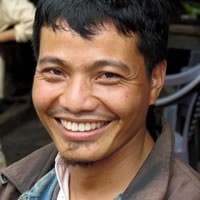Penesak in Indonesia

Photo Source:
Copyrighted © 2025
International Mission Board-SBC - Jacob Talley All rights reserved. Used with permission |
Send Joshua Project a map of this people group.
|
| People Name: | Penesak |
| Country: | Indonesia |
| 10/40 Window: | Yes |
| Population: | 156,000 |
| World Population: | 156,000 |
| Primary Language: | Musi |
| Primary Religion: | Islam |
| Christian Adherents: | 2.00 % |
| Evangelicals: | 0.00 % |
| Scripture: | Portions |
| Ministry Resources: | No |
| Jesus Film: | Yes |
| Audio Recordings: | Yes |
| People Cluster: | Musi of Sumatra |
| Affinity Bloc: | Malay Peoples |
| Progress Level: |
|
Introduction / History
The Penesak (or often, Meranjat) live in the province of South Sumatra. They live in the villages of Tanjung Batu District of Ogan Ilir Regency, as well as five villages in the Gelumbang District of Muara Enim Regency: Tambang Kelekar, Menanti, Tanjung Medang, Pelempang and Suban Baru. In addition, Penesak people also live in Meranjat Village, located in the Betung District of Banyuasin Regency. The Penesak people group is known by several other names including Meranjat, Tanjung Batu, Payaraman, Burai and Kelekar. The Penesak dialect is part of the Musi language which also includes the Lematang, Musi, Rawas, Palembang, Pegagan, and Belide.
What Are Their Lives Like?
The Penesak prefer to live in ethnic enclaves when they move out of the Penesak area, for example, to the Betung area of Banyuasin Regency. The Penesak are known as a friendly community. This is demonstrated by their engaging style of speech. They are known for openly addressing others, offering long explanations of all that they know on a topic and seeking to make others feel at home. The Penesak no longer have a traditional leader or chief; their leaders are general community members. Penesak people who move outside the area often go to Java; only a few have chosen to move to the South Sumatra provincial capital of Palembang. Those who go to Palembang move there to attend high school or college. On the other hand, most Penesak people who move to Java go there in order to work, not to further their education. Because land in the Penesak area is not very fertile, the people use slash-and-burn agriculture, moving after each season. The natural forests are becoming depleted due to the continuous search for fertile fields. Old fields are quickly overgrown by weeds and difficult to use for farming. The Penesak have had some success in cultivating rubber, pineapple, sugar cane and vegetables. Traditional customs are influenced by Islam. These include wedding, birth, death and circumcision ceremonies. One of the most strongly held customs is the wedding ceremony. When a marriage contract is made, the groom and his family visit the bride's family. The couple then returns as part of a procession to the groom's house to formalize the wedding plans. The engagement party is serenaded by tambourines and music. The groom wears a long white robe and a turban. The wedding ceremony is opened with long readings from the Koran (Islamic holy book).
What Are Their Beliefs?
Formally, the Penesak people are Muslim though they practice many spiritist beliefs in their daily living. The Penesak watch over the graves of their ancestors and consider them to be sacred places. Every village has a sacred burial ground that is said to possess its own supernatural power. They believe that this spiritual power was possessed by the ancestors buried in that place and is still effective long after the ancestor has died. For example, if, while he was still alive, a person was able to cause a plane to crash, an enemy plane that crosses over his grave will also crash. Every year, villagers visit and maintain the cemeteries in their villages as a required ritual.
What Are Their Needs?
The most urgent need is help in applying appropriate agricultural technology to overcome the problem of low soil fertility in their area. The Penesak also need local development because they live in remote areas. Improved education and opportunities for work could help the Penesak become more self-sufficient. Better training, medical staff and equipment are needed to improve health care in their area.
Prayer Points
Pray for the Lord to send dreams and visions to Penesak imams and family leaders.
Pray for the Lord to equip and send loving workers to their villages and families.
Pray for family-led Bible studies among the Penesaks.